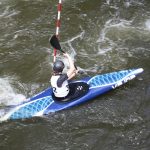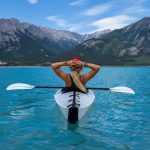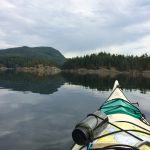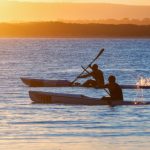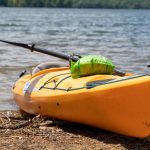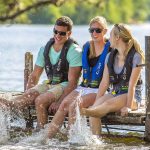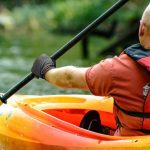From recreational kayaking to whitewater disciplines, we talk about various types of kayaking here.
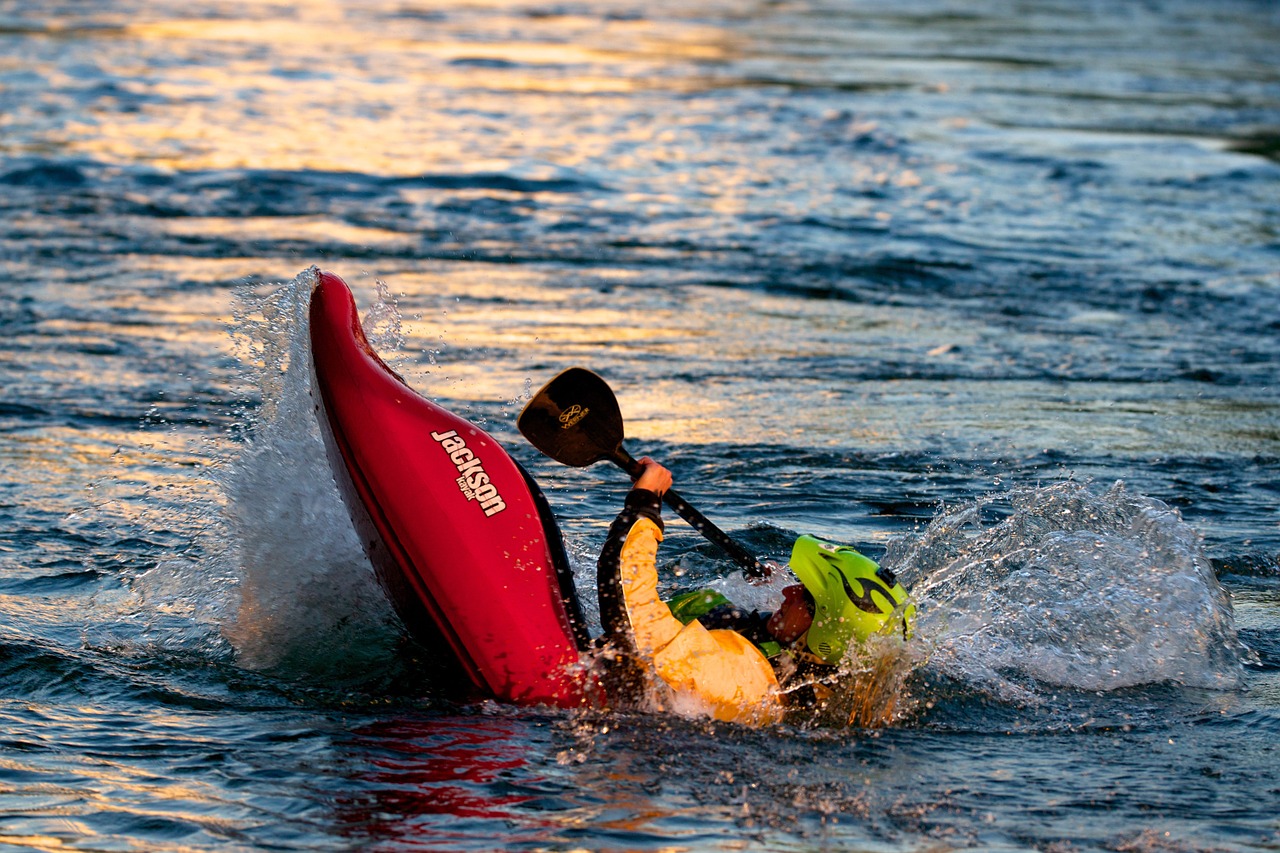
During the summer months, dressing for kayaking is as easy as NOT dressing, really.
Think about it: the water’s warm, the sun is high, and the breeze is cool. It’s an absolute no-brainer: just throw on your favorite bathing suit or bikini, and you’re ready for a day of paddling.
But it’s when the weather turns chilly, cool, or downright cold that things get a bit more complicated.
People who want to kayak during the spring and autumn months will need to dress to keep out the chill. Brave lunatics who kayak during winter (yes, this absolutely happens in sub-zero temperatures where I live in British Columbia!) have to really double down on ALL THE LAYERS.
In this post, I’ll break down all the clothing essentials you need for a day out on the water in any weather: warm, cool, or cold. I’ve also included a few game-changing essentials that will make for better, more comfortable, and (of course) safer paddling trips.
By the end, you’ll know everything you need to know about what to wear kayaking no matter the temperature or weather conditions.
As an affiliate of Amazon and other retailers, we may earn a small commission when you buy via our links, at no additional cost to you. Thank you!
The Single Most Important Thing to Wear Kayaking: Your PFD
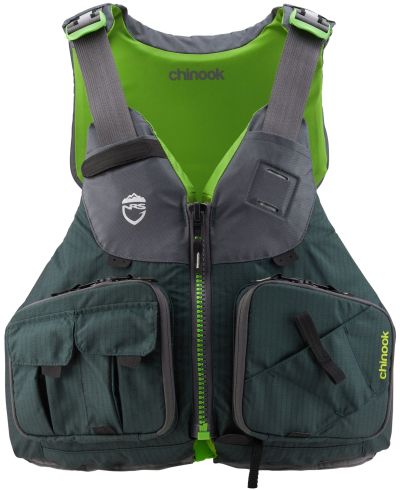
I absolutely CANNOT overstate how important your Personal Flotation Device is when out on the water. Whether you’re on a placid lake, whitewater rapids, or heading out to sea for some expedition kayaking, PFD can save your life.
No matter how skilled a paddler you are, there is always a non-zero chance that you could end up in the water.
It happens every year—some expert paddler ends up in a dangerous (and possibly fatal) situation that they couldn’t possibly have foreseen or expected. That’s just the nature of watersports. Even calm lakes have their dangers: underwater obstacles, dangerous wildlife, boggy lake beds, and more.
Wearing your PFD is the #1 thing you can do to stay safe while out paddling. It doesn’t matter how close to shore you are or how calm the water is—you should always wear your lifejacket. Yes, it may be uncomfortable, but it’s essential for your safety.
That, of course, makes your PFD the single most important thing you can wear while kayaking.
We wrote a whole article on How to Choose a PFD for Kayaking that will give you a lot of helpful information on what to look for in a lifejacket, what type of lifejacket to buy for your specific paddling conditions, sizing and buoyancy.
However, for the sake of brevity in this post, here are my top 3 PFD recommendations:
NRS Chinook – This fishing life jacket weighs just 2 pounds and only offers 16 pounds of buoyancy, but it’s perfect for calm conditions where the risk of falling overboard is slim. It comes with lots of accessory pockets for fishing gear, snacks, tools, and accessories, and it’s one of the most comfortable life jackets I’ve ever worn.
Astral V-Eight Fisher – On truly hot summer days, the last thing you want is to overheat because of some thick, stifling PFD. This beautifully ventilated lifejacket is the perfect solution, thanks to its breathable mesh lining, patented AirEscape system, and soft covering. It’s also wonderfully lightweight (just 1.37 pounds) and is made from non-toxic, recyclable foam.
Astral Airbelt – I love that I can use this inflatable PFD for both kayaking and stand-up paddleboarding. It’s super low-profile, weighs next to nothing, and because I can wear it as a belt rather than a vest, it stays out of my way when paddling hard. It’s also incredibly durable and is rated for 22 pounds of buoyancy.

Always remember: no paddling outfit is complete without a proper life jacket!
Dressing for Warm or Hot-Weather Kayaking
When kayaking in warm or hot weather, there’s really no need to dress it up. I spend most of my summer paddling trips in as little clothing as possible so I can make the most of the (sadly few) months of the bright Canada sun and heat.
However, I will say that there are a few items of clothing that are ESSENTIAL for warm/hot-weather kayaking.
Board Shorts/Swimsuit/Athletic Shorts
Women can enjoy kayaking or paddleboarding in a bathing suit or bikini. Some guys are confident enough to go kayaking in their underwear–good for them, but for the rest of us “average Joes”, a good pair of shorts is a must-have.
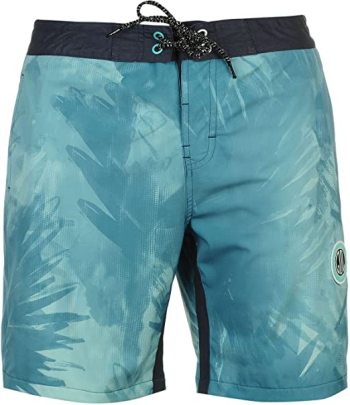
Pretty much any pair of board shorts, swim trunks, or even athletic shorts (made with quick-drying synth+etic fabric) will serve as the most basic item of kayaking clothing.
UV-Resistant Shirt or Rash Guard
Your lower body will be inside the kayak (and beneath the spray skirt, if that’s your style), but most of your upper body is going to be exposed to the sun. That means you risk A) sunburn and B) higher probability of melanoma because of all the UV radiation in sunlight.
It’s recommended that you wear a rash guard or shirt with built-in UV protection (high UPF rating, or darker fabrics with denser weaves) to reduce your risk of skin cancer and shield you from sunburn. Just make sure it’s a quick-drying, moisture-wicking, breathable synthetic material that will stay comfortable after hours of sweating.
Hat

A hat serves a number of purposes. It can keep water from splashing on your face and keep the sun out of your eyes. It also protects your face and neck from excessive sun exposure. You can go with the standard baseball cap, a wide-brimmed angler’s cap, or pretty much any kind of hat that will offer some protection against the sun. Trust me, after a long day out on the water, it can make a MASSIVE difference.
Sunglasses
Sunglasses will absolutely make you look ever-so-cool when paddling, but they’re also a practical addition to your kayaking wardrobe. The sun can be brutally and blindingly bright early in the morning and late in the afternoon when it’s hanging low in the sky and shining right in your eyes. The water, too, reflects a lot of glare all day long. Excessive brightness can tire out (and possibly accelerate the deterioration of) your eyes. Plus, squinting speeds up the formation of wrinkles and lines around your eyes and mouth. Wearing UV-resistant sunglasses also shields your eyes from the radiation in sunlight.
(Note: Consider using a strap to keep the sunglasses from getting lost if they fall off or you capsize. It may “ding” your coolness factor, but it’ll stop you from losing a potentially expensive pair of sporty sunglasses!)
Neck Protection
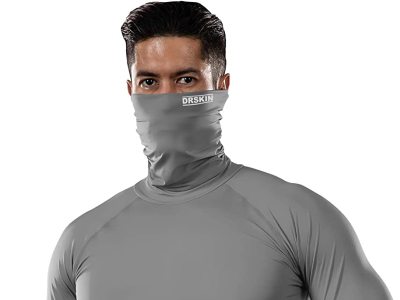
The one part of our bodies we most often forget to protect is the back of our neck—which, of course, means it’s the part most likely to get sunburned. Some people solve this problem by wearing their baseball cap with the brim turned backwards (though I find this just creates the problem of allowing water to splash on my face more), or using a wide-brimmed angler’s hat (a much more effective solution).
However, you can also use a bandanna or a turtleneck-style rash guard or athletic shirt to protect your neck. I’ve been using the Dr. Skin MASK Turtleneck Compression Shirt for a couple of years now, and I love how well the high collar prevents sunburn on the back of my neck.
Sandals/Flip Flops/Water Shoes
A lot of people prefer to kayak barefoot, but I prefer wearing shoes because I need something between my toes and the pedals of my kayak. It just makes it more comfortable for me to push off against the pedals when I’m driving hard. When I paddle barefoot, my feet actually feel bruised after a few hours.
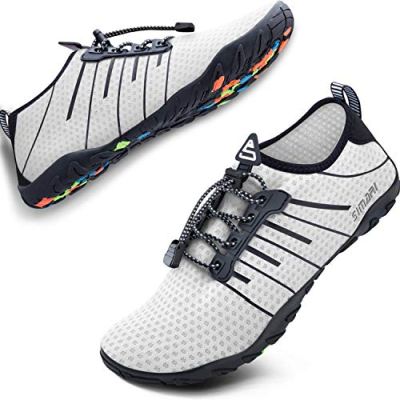
Sandals are a classic staple here in Canada (though I will never be caught dead wearing socks and sandals!) and make for good kayaking footwear. I’m not a fan of flip flops when paddling, but my wife prefers them to sandals.
However, my go-to has been water shoes: shoes with a thicker rubber sole that provide good cushioning and breathable mesh upper that allows water to drain out. I’ve been using the SIMARI Water Shoes since last summer and absolutely love how lightweight and slim they are, but they do wonders to protect my feet against both cold water and the hard plastic of my kayak foot pedals.
Spray Top
This is a piece of clothing I recommend for anyone who is kayaking out at sea, where high waves and heavy winds can kick up a lot of spray. Ocean water is always much colder than lake or river water, so even on the hottest summer day, the spray can be annoyingly chilly.
A spray top is basically a waterproof blend between a windbreaker and rain jacket that you can wear over your rash guard or athletic shirt. I have only worn the WindRider Spray Top a few times, but it makes a huge difference in keeping me warm and dry when paddling around Vancouver’s English Bay.

Sunscreen
Last but certainly not least, you NEED (yes, in all caps!) sunscreen. Sunscreen will shield your skin from UV radiation, protect against sunburn, and add a layer of oil that prevents skin dryness. The American Academy of Dermatology recommends:
- Applying sunscreen 15 minutes before going outdoors
- Applying sunscreen to every part of your body not covered by clothing
- Reapplying sunscreen every 2 hours, or more frequently after sweating and/or swimming
- Using a lip balm with an SPF rating of at least 30
- Using an SPF30 (or higher) sunscreen that is water-resistant
Dressing for Cool or Cold-Weather Kayaking
Dressing for kayaking in cool or cold weather is a much more serious proposition. You’ve got to choose an outfit that will protect you from the elements while still being versatile and flexible enough to stay comfortable for a multi-hour or all-day paddling trip.
If you’re going to go kayaking during the cooler/colder months (from late autumn to early spring), there are a few things you need to know!
Dress for the Water Temperature, Not Air Temperature
This is an absolutely crucial piece of advice to remember when planning your kayaking outfits!
Don’t get me wrong: wind chill can be absolutely brutal and increase the dangers of cold weather. However, cold water is a greater danger because it leads to hypothermia faster than cold air.
According to experts, hypothermia can set in at ambient temperatures of around 50 F (10 C), but in the water, the temperatures only need to be around 60-70 F (16-21 C) for hypothermia to set in.
Plus, as I explained in my “Dangers of Kayaking” article, there is the risk of “shock” and “gasp reflex” if you capsize or fall in. When you hit cold water, your body instinctively sucks in air, and it can trigger a hyperventilation-like reaction: your breathing speeds up and you can start to feel like you’re panicking. After 10-20 minutes in cold water (or with cold water clinging to your wet clothes), you are at serious risk of hypothermia.
That’s not to say that cold weather (especially damp, windy, or rainy weather) isn’t a threat. It’s just not the biggest threat you’ll face out kayaking. Your outfits should always take into account how cold the water is first and foremost. Even if that means you’re bundled up with what feels like one too many layers, it’s always best to be extra-safe when dealing with cold temperatures.
Choosing the Right Clothing for Cold-Weather Kayaking
When cool or cold-weather kayaking, you need to shield your body from both the water and the cold temperatures.
On your upper body, always wear three (possibly four) layers:
Base Layer
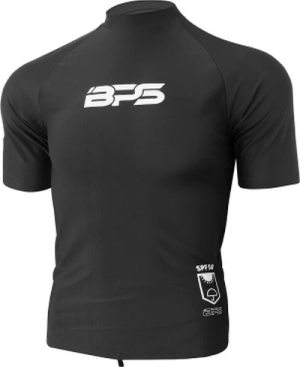
Your base layer (against your skin) should be made using synthetic fabrics that pull moisture away from your body and dry quickly. This both prevents the build-up of sweat and keeps you from getting chilled. Pretty much any athletic-style shirt or rashguard will do the trick. (I highly recommend the BPS UPF 50+ Rash Guard, which is lightweight, beautifully flexible, and includes UV protection. It’s a summer shirt that can work as a winter base layer, too.)
Insulating Layer/s
Adding one or two layers for insulation will keep out even a biting wind chill in the dead of winter. For cool-weather kayaking, just one lightweight layer—like my personal favorite, the Columbia Men’s PFG Terminal Tackle Hoodie—will do. When it gets cold, you may want to add a second insulating layer: either a thicker sweater or a jacket.
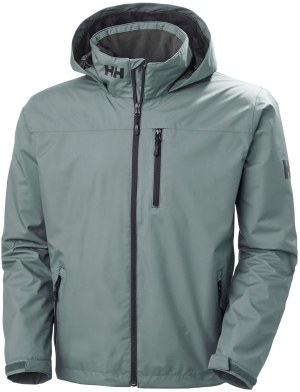
Waterproof Layer
This is the final piece of the puzzle: a layer that blocks off the wind and protects you and your clothing from water. You can stick with a lightweight “shell”—a waterproof windbreaker or rain jacket like the Helly-Hansen 33874 Crew Hooded Jacket, for example—or go for a thicker, heavier raincoat that offers full protection from ocean spray, rain, and the water flying off your paddles.
On your lower body, always wear two (possibly three) layers:
Underwear
You want to use athletic-style underwear made of the same quick-drying, moisture-wicking fabrics as your shirt, or you can opt for baselayer running leggings or tights. I use the Under Armour Men’s HeatGear Leggings for snowboarding, and they work perfectly as the base layer for cold-weather kayaking, too.
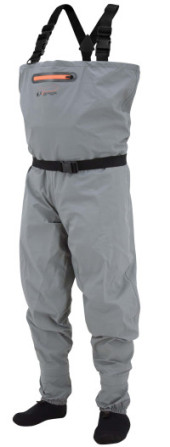
Pants
For pants, you want something that maximizes warmth while offering at least a reasonable degree of waterproofing. Hunting pants are an excellent choice, as are rain pants like the Acme Projects Rain Pants. Basically, you’re looking for pants with a warm inner lining and a waterproof exterior shell.
If you’re really dead set on keeping out the cold and wet completely, you can always wear a pair of waders over your pants. Waders are designed specifically for use in cold weather and wet conditions. They’re basically pants with a good pair of boots built in, and they’ll keep you perfectly dry and warm all day long. I use the Frogg Toggs Canyon II waders which are made of a super-tough nylon and PVC blend, and feature very comfortable boots perfect for sitting in a kayak all day long.
Dressing for Cold-Weather Kayaking: Five Crucial Factors to Keep in Mind
Weather/Waterproofing
You want to keep water away from your body as much as possible. That means choosing exterior layers of clothing that serve as an impermeable barrier between you and water—both the water in the river/lake/ocean, and any rain or spray.
Sweat Management
As you paddle, you’re going to sweat. Sweat that dries on your skin can leave salt crystals that rub/chafe, and if it soaks into your clothing, it can lead you to feel damp and can increase the risk of getting cold. That’s why your base layer (the layer against your skin) should always be made with some form of quick-drying, moisture-wicking synthetic fabric.
Freedom of Movement
You’re going to have a hard time kayaking if you can’t move your arms or torso freely. The clothing has to be loose enough that you can twist and paddle comfortably.
Abrasion Resistance
The repetitive movements of paddling your kayak could wear down or tear any garments that aren’t manufactured to be abrasion-resistant. Always consider friction (between your back and the kayak seat, your legs and the kayak’s gunwales/cockpit, your arms rubbing against your sides, etc.) when choosing your clothing.
No “Rustable” Hardware
Any zippers, fasteners, buckles, or snaps made with metal will be prone to rusting if they get wet. Try to find clothing that doesn’t have any of this type of hardware—or uses hardware specifically designed to be rust-resistant.
Cotton Clothing: The Biggest No-No for Kayakers
Cotton is a terrible fabric that you should never use for A) the majority of sports where you will sweat, and B) a base layer for cold-weather activities.
Why is that? Simple: cotton absorbs sweat, pulling it away from the body, but then it tends to get really heavy and soggy while staying damp. Cotton dries very slowly, meaning all that sweat is stuck right up against your skin. Not only will salt crystals form (leading to chafing), but that damp cotton will also get cold—meaning you’ll get cold.
Cotton is a great hot-weather fabric, but for winter, steer well clear of cotton as much as possible. That goes DOUBLE when you’re anywhere with the possibility that you and/or your clothing might get wet.
Accessories for Cold-Weather Kayaking
You’ve got the clothes, but now it’s time to add accessories that keep you warm, comfortable, and safe while kayaking during cool or cold months. Vital cold-weather kayaking accessories include:
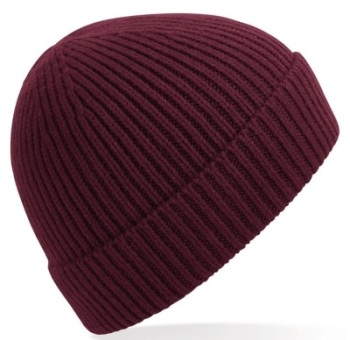
Hat
You’ll want a hat that keeps off the sun, shields you from water, and increases your warmth. Fisherman caps, for example, are made using waxed canvas that is waterproof on the outside and offers good warmth on the inside. Or, wear a beanie (toques, as we Canucks call them) under your kayaking helmet or a waterproof fishing hat if the weather is really cold. The beanie isn’t waterproof, but it’ll help to keep your ears warm in the wind.
Sunglasses
The winter sun is just as harsh as the summer sun—in fact, the sun shining off snow and ice can be even more ferocious and lead to snow-blindness. It’s always a good idea to wear sunglasses in sunny weather, but they can come in handy to protect your eyes (and upper portion of your face) from icy winter winds.
Sunscreen
It may be cool or cold, but the sun’s still shining and those UV rays are still a danger. Make sure you apply sunscreen to any patches of your skin not covered by your may layers of clothing!
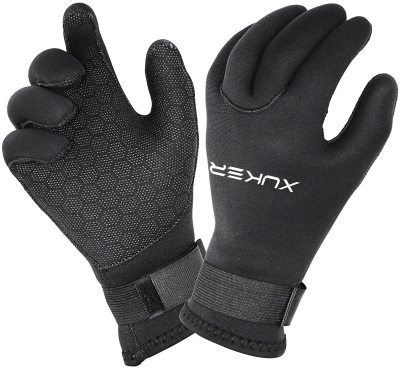
Waterproof Paddling Gloves
Dipping your hands into cold/freezing water can be painful—and, in some conditions, even lead to frostbite. It’s a good idea to wear waterproof paddling gloves, which keep your hands both warm and dry. A buddy of mine swears by his XUKER Water Gloves, neoprene diving gloves with anti-slip rubber palms, and Velcro straps that are easy to secure in place.
Warm Socks + Waterproof Shoes/Boots
Just like your hands, your feet are highly susceptible to frostbite in winter conditions, or can increase the risk of hypothermia if they get wet. If you’re kayaking in cold or cool weather, it’s a good idea to wear a pair of warm snowboarding socks beneath a pair of waterproof calf- or knee-high boots. That way, you can launch your boat without getting your feet wet. Or, if the water’s just a little chilly, try the Cressi Neoprene Boots, the sort of lightweight neoprene footwear typically worn with wetsuits. They are not waterproof but will keep your feet warm even when wet.
Wetsuits vs. Dry Suits
If you’re going to be paddling in very cold conditions where hypothermia is a risk (as mentioned above, 60-70 F), you may want to consider wearing either a wetsuit or a dry suit.
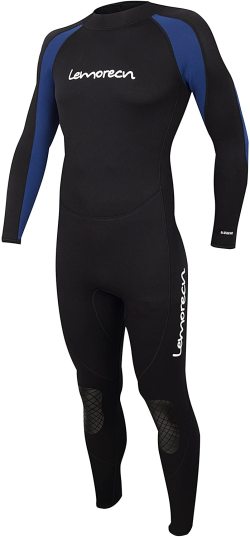
What is a Wetsuit?
Wetsuits are typically made from thick neoprene and are designed to be fully skin-tight but not waterproof. In fact, they allow a little bit of water to seep inside the suit, but that water gets warmed up by your body heat and ultimately acts as a layer of insulation against the cold water around you.
You’ll want to wear a wetsuit in environments where the water is just too cold for you to safely swim without risking hypothermia. They’ll provide good insulation against the cold—both cold water and cold air—especially if you’re in situations where you run a high risk of getting wet, i.e. turbulent or choppy waters that could cause you to capsize or take on water. Best of all, they even provide a bit of buoyancy to keep you afloat.
For great wetsuits, try:
O’Neill Men’s Reactor II – This long-sleeved wetsuit is designed for full-body coverage, and the “smoothskin” synthetic fabric provides an added layer of insulation against the cold. You’ll love how flexible the ultrastretch neoprene is, and it’s a high-performance wetsuit.
Lemorecn Wetsuit – Though not as “cutting edge” as the O’Neill, it’s a budget-friendly choice that will be more than capable of withstanding cool-weather paddling conditions. It’s designed specifically for kayaking (as well as paddleboarding, scuba diving, and surfing) and comes with extra reinforcement at the seams to keep it from breaking or fraying with repetitive paddling movements.
What is a Drysuit?
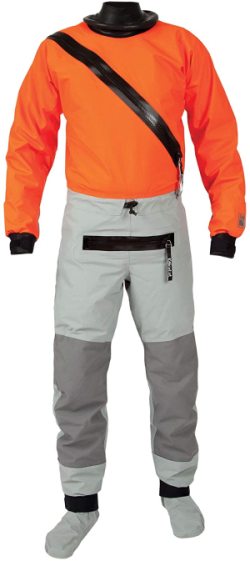
A dry suit is a nylon, PVC, or polyester suit designed to keep you absolutely dry. It’s not very thick or very warm, but it’s entirely waterproof. Higher-end drysuits are also breathable.
The cuffs and collar of a drysuit are usually made with latex gaskets that are completely watertight. Many drysuits also come with built-in “booties” that go inside whatever shoes or boots you’re wearing.
Dry suits are the best choice in TRULY COLD environments. They’re worn atop thermal clothing and serve as the waterproofing top layer that will keep you dry even if you fall into arctic or frigid waters. They are going to be a bit hot and stuffy in “cool” and “mildly cold” conditions, but if you’re planning on doing some winter kayaking, you’ll want a dry suit for sure.
The biggest downside of drysuits is the price tag. A high-end drysuit with a Gore-Tex membrane can easily set you back a cool $1,000. Is it worth it, considering that it can save your life one day? You decide.
I recommend Kokatat Hydrus Swift Entry Drysuit w/Zipper as a great all-purpose dry suit. It is made with Kokatat’s own Hydrus 3.0 three-layer membrane, which is considerably cheaper than Gore-tex. A great feature is a relief zipper which lets you answer nature’s call without taking the suit off. There is also a women’s version.
For kayak anglers, there’s the Kokatat Supernova Hydrus Angler Semi-Dry Suit. It’s labeled as “semi-dry” because the neck gasket is made of neoprene and not latex. This is way more comfortable during long days of fishing, but the neoprene collar will let some water in if you take a dip.
FAQ
It’s recommended that you treat any water colder than 70 F with caution, and you should always wear a wetsuit when around water below 60 F. Water colder than 60 F may be cold enough that you risk the “cold water gasp reflex” and “cold water shock”. You’re also at high risk of hypothermia if the water is 60 F or colder.
However, with the right gear and clothing (everything we listed above), you can safely kayak in pretty much any weather. So the real answer to this question is, “When you don’t have the right outfit to keep you safe from the cold!”
Yes and no, depending on your winter. For example, a winter in Texas will be around 23-26 F (during the coldest months of the year), while winter in northern British Columbia can drop as low as 10-16 F (during the coldest months). Winters in Arizona and Florida are far milder than winters in Alaska or the Yukon.
It’s all about how cold winter in YOUR area gets. If it’s not below freezing temperatures, you’re dealing with cold-weather conditions—which you can easily gear up for. However, when the conditions turn frigid or arctic, that’s when you should kayak with extreme caution.
This is a very nifty rule of thumb for kayakers (and anyone who engages in watersports) to decide whether or not to wear a wetsuit or drysuit. Add together the water and air temperatures (in Fahrenheit, not Celsius), and if the total is above 120, it’s safe to paddle without the need for any additional protection. If the total is below 120, you’re better off with a dry suit or wetsuit, depending on the conditions.
To put it into an example you can understand:
– The water temperature is 65 F and the ambient air temperature is 40 F. With a total of 105, you need to wear a wetsuit or drysuit.
– The water temperature is 75 F and the ambient temperature is 65 F. With a total of 140, you’re fine to get in the water without immersion wear.
The “optimal” temperature for swimming is around 78 F, though the average surface sea temperature in the northern Pacific Ocean ranges between 45 and 61 F, while the northern Atlantic Ocean is a few degrees warmer.
Water temperature below 50 F is considered “extremely dangerous” because it saps your body heat and drastically increases the risk of hypothermia. It’s recommended that you use immersion wear (wetsuit, dry suit, or even scuba gear) if entering water colder than 60 F.

